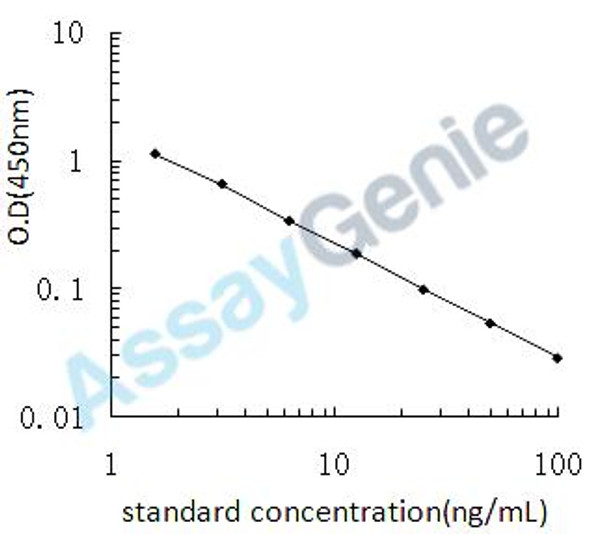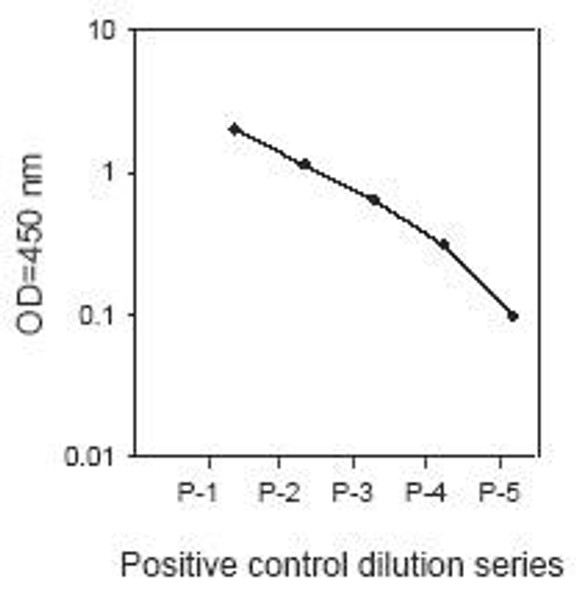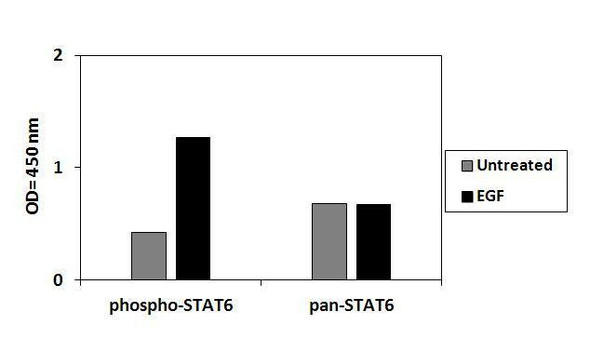Mouse STAT6 ELISA Kit (MOFI01127)
- SKU:
- MOFI01127
- Product Type:
- ELISA Kit
- Size:
- 96 Assays
- Uniprot:
- P52633
- Sensitivity:
- 46.875pg/ml
- Range:
- 78.125-5000pg/ml
- ELISA Type:
- Sandwich
- Synonyms:
- STAT6, D12S1644, IL-4 Stat, IL-4-STAT, signal transducer and activator of transcription 6, signal transducer and activator of transcription 6, interleukin-4 induced, STAT, interleukin4-induced, STAT6B, STAT6C, transcription factor IL-4 STAT
- Reactivity:
- Mouse
- Research Area:
- Epigenetics and Nuclear Signaling
Description
Mouse STAT6 ELISA Kit
The Mouse STAT6 ELISA Kit is a valuable tool for the precise measurement of STAT6 levels in mouse serum, plasma, and tissue homogenates. With its superior sensitivity and specificity, this kit delivers consistent and trustworthy results, making it perfect for a variety of research applications.STAT6 is a key transcription factor that plays a critical role in immune responses, particularly in the regulation of Th2 cell differentiation and allergic inflammation.
Dysregulation of STAT6 has been implicated in various diseases, including asthma, allergies, and autoimmune disorders, making it a significant target for further exploration and therapeutic development.Overall, the Mouse STAT6 ELISA Kit provides researchers with a reliable method for studying STAT6 function and its potential implications in disease pathology and treatment strategies.
| Product Name: | Mouse STAT6 ELISA Kit |
| Product Code: | MOFI01127 |
| Size: | 96 Assays |
| Alias: | STAT6, D12S1644, IL-4 Stat, IL-4-STAT, signal transducer and activator of transcription 6, signal transducer and activator of transcription 6, interleukin-4 induced, STAT, interleukin4-induced, STAT6B, STAT6C, transcription factor IL-4 STAT |
| Detection Method: | Sandwich ELISA |
| Application: | This immunoassay kit allows for the in vitro quantitative determination of Mouse STAT6 concentrations in serum plasma and other biological fluids. |
| Sensitivity: | 46.875pg/ml |
| Range: | 78.125-5000pg/ml |
| Storage: | 4°C for 6 months |
| Note: | For Research Use Only |
| Recovery: | Matrices listed below were spiked with certain level of Mouse STAT6 and the recovery rates were calculated by comparing the measured value to the expected amount of Mouse STAT6 in samples. | ||||||||||||||||
| |||||||||||||||||
| Linearity: | The linearity of the kit was assayed by testing samples spiked with appropriate concentration of Mouse STAT6 and their serial dilutions. The results were demonstrated by the percentage of calculated concentration to the expected. | ||||||||||||||||
| |||||||||||||||||
| Intra Assay: | CV <8% | ||||||||||||||||
| Inter Assay: | CV <10% |
| Component | Quantity | Storage |
| ELISA Microplate (Dismountable) | 8×12 strips | 4°C for 6 months |
| Lyophilized Standard | 2 | 4°C/-20°C |
| Sample/Standard Dilution Buffer | 20ml | 4°C |
| Biotin-labeled Antibody(Concentrated) | 120ul | 4°C (Protect from light) |
| Antibody Dilution Buffer | 10ml | 4°C |
| HRP-Streptavidin Conjugate(SABC) | 120ul | 4°C (Protect from light) |
| SABC Dilution Buffer | 10ml | 4°C |
| TMB Substrate | 10ml | 4°C (Protect from light) |
| Stop Solution | 10ml | 4°C |
| Wash Buffer(25X) | 30ml | 4°C |
| Plate Sealer | 5 | - |
Other materials and equipment required:
- Microplate reader with 450 nm wavelength filter
- Multichannel Pipette, Pipette, microcentrifuge tubes and disposable pipette tips
- Incubator
- Deionized or distilled water
- Absorbent paper
- Buffer resevoir
| Uniprot | P52633 |
| UniProt Protein Function: | STAT6: transcription factor of the STAT family. Plays a central role in IL4-mediated biological responses. Induces the expression of BCL2L1/BCL-X(L), which is responsible for the anti-apoptotic activity of IL4. May function in the differentiation of T helper 2 cells and class switch of immunoglobulins. Forms homo- or heterodimers that translocate into the nucleus where they regulate transcription. |
| UniProt Protein Details: | Protein type:DNA-binding; Transcription factor Chromosomal Location of Human Ortholog: 12q13 Cellular Component: nucleoplasm; nuclear chromatin; cytoplasm; cytosol; lipid raft Molecular Function:identical protein binding; signal transducer activity; protein binding; transcription factor activity; protein phosphatase binding Biological Process: regulation of transcription from RNA polymerase II promoter; T-helper 1 cell lineage commitment; negative regulation of T-helper 2 type immune response; transcription, DNA-dependent; positive regulation of interferon type I production; innate immune response; mammary gland epithelial cell proliferation; positive regulation of transcription from RNA polymerase II promoter; negative regulation of transcription from RNA polymerase II promoter; signal transduction; positive regulation of isotype switching to IgE isotypes; regulation of cell proliferation |
| NCBI Summary: | The protein encoded by this gene is a member of the STAT family of transcription factors. In response to cytokines and growth factors, STAT family members are phosphorylated by the receptor associated kinases, and then form homo- or heterodimers that translocate to the cell nucleus where they act as transcription activators. This protein plays a central role in exerting IL4 mediated biological responses. It is found to induce the expression of BCL2L1/BCL-X(L), which is responsible for the anti-apoptotic activity of IL4. Knockout studies in mice suggested the roles of this gene in differentiation of T helper 2 (Th2) cells, expression of cell surface markers, and class switch of immunoglobulins. Alternative splicing results in multiple transcript variants.[provided by RefSeq, May 2010] |
| UniProt Code: | P52633 |
| NCBI GenInfo Identifier: | 296010864 |
| NCBI Gene ID: | 6778 |
| NCBI Accession: | NP_001171549.1 |
| UniProt Secondary Accession: | P52633,P52633, |
| UniProt Related Accession: | P42226 |
| Molecular Weight: | 94kDa |
| NCBI Full Name: | signal transducer and activator of transcription 6 isoform 1 |
| NCBI Synonym Full Names: | signal transducer and activator of transcription 6 |
| NCBI Official Symbol: | STAT6 |
| NCBI Official Synonym Symbols: | STAT6B; STAT6C; D12S1644; IL-4-STAT |
| NCBI Protein Information: | signal transducer and activator of transcription 6 |
| UniProt Protein Name: | Signal transducer and activator of transcription 6 |
| UniProt Synonym Protein Names: | IL-4 Stat |
| Protein Family: | Signal transducer and transcription activator |
| UniProt Gene Name: | STAT6 |
| UniProt Entry Name: | STAT6_HUMAN |
*Note: Protocols are specific to each batch/lot. For the correct instructions please follow the protocol included in your kit.
| Step | Procedure |
| 1. | Set standard, test sample and control (zero) wells on the pre-coated plate respectively, and then, record their positions. It is recommended to measure each standard and sample in duplicate. Wash plate 2 times before adding standard, sample and control (zero) wells! |
| 2. | Aliquot 0.1ml standard solutions into the standard wells. |
| 3. | Add 0.1 ml of Sample / Standard dilution buffer into the control (zero) well. |
| 4. | Add 0.1 ml of properly diluted sample (Human serum, plasma, tissue homogenates and other biological fluids.) into test sample wells. |
| 5. | Seal the plate with a cover and incubate at 37 °C for 90 min. |
| 6. | Remove the cover and discard the plate content, clap the plate on the absorbent filter papers or other absorbent material. Do NOT let the wells completely dry at any time. Wash plate X2. |
| 7. | Add 0.1 ml of Biotin- detection antibody working solution into the above wells (standard, test sample & zero wells). Add the solution at the bottom of each well without touching the side wall. |
| 8. | Seal the plate with a cover and incubate at 37°C for 60 min. |
| 9. | Remove the cover, and wash plate 3 times with Wash buffer. Let wash buffer rest in wells for 1 min between each wash. |
| 10. | Add 0.1 ml of SABC working solution into each well, cover the plate and incubate at 37°C for 30 min. |
| 11. | Remove the cover and wash plate 5 times with Wash buffer, and each time let the wash buffer stay in the wells for 1-2 min. |
| 12. | Add 90 µL of TMB substrate into each well, cover the plate and incubate at 37°C in dark within 10-20 min. (Note: This incubation time is for reference use only, the optimal time should be determined by end user.) And the shades of blue can be seen in the first 3-4 wells (with most concentrated standard solutions), the other wells show no obvious color. |
| 13. | Add 50 µL of Stop solution into each well and mix thoroughly. The color changes into yellow immediately. |
| 14. | Read the O.D. absorbance at 450 nm in a microplate reader immediately after adding the stop solution. |
When carrying out an ELISA assay it is important to prepare your samples in order to achieve the best possible results. Below we have a list of procedures for the preparation of samples for different sample types.
| Sample Type | Protocol |
| Serum: | If using serum separator tubes, allow samples to clot for 30 minutes at room temperature. Centrifuge for 10 minutes at 1,000x g. Collect the serum fraction and assay promptly or aliquot and store the samples at -80°C. Avoid multiple freeze-thaw cycles. If serum separator tubes are not being used, allow samples to clot overnight at 2-8°C. Centrifuge for 10 minutes at 1,000x g. Remove serum and assay promptly or aliquot and store the samples at -80°C. Avoid multiple freeze-thaw cycles. |
| Plasma: | Collect plasma using EDTA or heparin as an anticoagulant. Centrifuge samples at 4°C for 15 mins at 1000 × g within 30 mins of collection. Collect the plasma fraction and assay promptly or aliquot and store the samples at -80°C. Avoid multiple freeze-thaw cycles. Note: Over haemolysed samples are not suitable for use with this kit. |
| Urine & Cerebrospinal Fluid: | Collect the urine (mid-stream) in a sterile container, centrifuge for 20 mins at 2000-3000 rpm. Remove supernatant and assay immediately. If any precipitation is detected, repeat the centrifugation step. A similar protocol can be used for cerebrospinal fluid. |
| Cell culture supernatant: | Collect the cell culture media by pipette, followed by centrifugation at 4°C for 20 mins at 1500 rpm. Collect the clear supernatant and assay immediately. |
| Cell lysates: | Solubilize cells in lysis buffer and allow to sit on ice for 30 minutes. Centrifuge tubes at 14,000 x g for 5 minutes to remove insoluble material. Aliquot the supernatant into a new tube and discard the remaining whole cell extract. Quantify total protein concentration using a total protein assay. Assay immediately or aliquot and store at ≤ -20°C. |
| Tissue homogenates: | The preparation of tissue homogenates will vary depending upon tissue type. Rinse tissue with 1X PBS to remove excess blood & homogenize in 20ml of 1X PBS (including protease inhibitors) and store overnight at ≤ -20°C. Two freeze-thaw cycles are required to break the cell membranes. To further disrupt the cell membranes you can sonicate the samples. Centrifuge homogenates for 5 mins at 5000xg. Remove the supernatant and assay immediately or aliquot and store at -20°C or -80°C. |
| Tissue lysates: | Rinse tissue with PBS, cut into 1-2 mm pieces, and homogenize with a tissue homogenizer in PBS. Add an equal volume of RIPA buffer containing protease inhibitors and lyse tissues at room temperature for 30 minutes with gentle agitation. Centrifuge to remove debris. Quantify total protein concentration using a total protein assay. Assay immediately or aliquot and store at ≤ -20 °C. |
| Breast Milk: | Collect milk samples and centrifuge at 10,000 x g for 60 min at 4°C. Aliquot the supernatant and assay. For long term use, store samples at -80°C. Minimize freeze/thaw cycles. |









